Mercedes W220 S-Class 1999 – 2005


The Mercedes-Benz product drive launched more than five years previously reached new heights with the introduction of the 220 series S-Class sedan at the Paris Motor Show in September 1998.

The European market launch of the new Mercedes-Benz flagship sedan followed in October 1998 – one month after the world premiere.

The new S-Class, conceived as a big touring sedan with a superior level of comfort, improved passive safety and unsurpassed performance, is the latest model range of a long tradition stretching back decades; there has, however, been a certain shift in emphasis since its predecessor, the 140 series.

When the new specifications book came out in 1993, the 140 series had been on the market for two years and the new development targets not only appeared highly demanding but also somewhat self-contradictory:

the demands included improved performance yet reduced fuel consumption, increased safety and a comprehensive range of equipment coupled with a reduction in weight; more room was also specified, but so were reduced exterior dimensions and a new, slimmer design.

The 220 series S-Class demonstrates that Daimler-Benz engineers have succeeded in overcoming these apparent contradictions, whilst making lasting improvements to a model series which was already acknowledged to be of a very high standard.
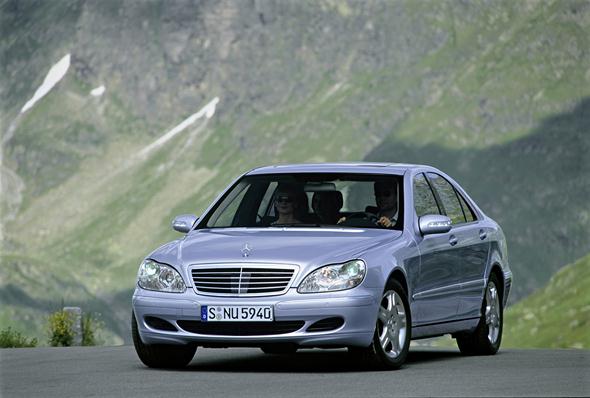
An elegant, dynamic appearance and a large number of technical innovations have given the new S-Class the necessary quality to continue and further expand on the global success enjoyed by its predecessor model.

Over 30 new developments, for which a total of 340 patents were registered, make the Mercedes-Benz S-Class once again the trend-setter in all areas of passenger car design. A large number of the innovations which Daimler-Benz is the world’s first automobile manufacturer to offer are included as standard in the new S-Class.

As has been the case in Mercedes-Benz prestige range sedans for generations, the 220 series is available in two wheelbase length variants.
In addition to the regular version, an extended wheelbase model is also available, in which the extra 120 mm are used exclusively to increase leg room in the rear passenger compartment.

Despite reduced external dimensions, the new S-Class has maintained an equally generous level of room for the driver and passengers.
Thanks to optimized use of space, the length of the longer variant’s interior has been extended by 37 mm, even though the exterior dimensions of the car are 55 mm shorter.

Reducing the height of the vehicle by 41 mm has created a flat, elongated silhouette which gives the new S-Class coupe-like character and emphasizes the dynamic and elegant design.
Thanks to the modified seat position the headroom for the driver and front passenger has been increased by 6 mm despite the actual reduction in the height of the car.

An innovative combination of aluminum, plastic and high-strength steel has enabled the new S-Class to become an average 210 kg lighter than its predecessor model.
Depending on the level of equipment, the weight saving can be as much as 300 kg, or 16 %, according to the model.

A total of 14 % of the sheet-metal parts of the new S-Class are made of aluminum including the cross members of the front and rear modules, new crash boxes in the front end structure, the frame-type integral support for the engine and front axle bolted to the body, the rear bulkhead behind the rear seats and the engine hood.

Increased use of high-strength steel also allows for a more lightweight construction by permitting a substantial reduction in material thickness whilst retaining the same strength.
The proportion of these high-strength steel varieties in the new S-Class is 38 %, representing more than double the figure for the predecessor model.

The new modular construction methods allow both more economical production and easier repairs. The front and rear ends of the new S-Class consist of modules that are assembled off the production line and then bolted as complete units to the body.
As a result, the front and rear modules can be replaced inexpensively when repairing accident damage, because no welding work is required.

The detachable front module also includes aluminum crash boxes that are bolted to the front side members.
These crash boxes absorb a major proportion of the impact energy of minor scrapes (up to 15 kph impact speed), so that the load-bearing structure behind them remains undamaged.

As a result of the reduced repair costs that this construction ensures, the S-Class models are classified in lower insurance groups by German insurers.
The new S-Class redefines standards in passive safety. Legally prescribed crash tests, such as the EU front-end impact against a deformable barrier, or the ECE side impact test, are successfully passed by the W 220 with a much higher crash speed than required.

Bodyshell reinforcements, additional load-bearing members, higher-quality materials and innovative restraint systems, which increase the weight of the car by 43 kg, all help the new S-Class to achieve such an impressive crash test performance.
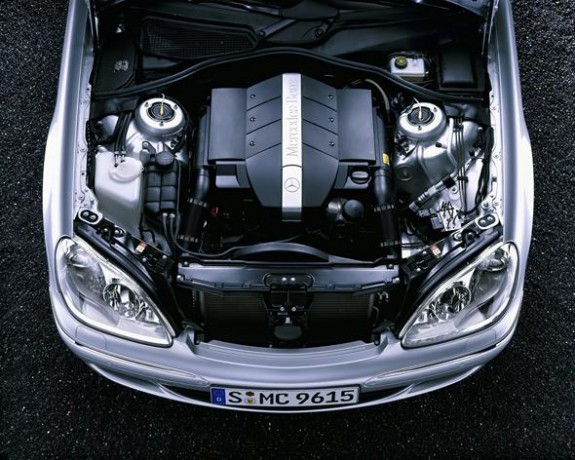
Whereas in previous years Daimler-Benz engineers have concentrated largely on frontal collisions, attaining very high standards, attention is now increasingly being paid to side impact.
The side impact protection of the new S-Class is based on a number of separate design features which have combined to create a safety concept that is active on three levels.

In the roof area, continuous three-shell A-, B- and C-pillars, thicker metal sheeting in the most heavily stressed parts of the side panels and additional reinforcements in the side sections of the roof frame ensure optimal transverse support.

As far as restraints are concerned, doors with high transverse strength overlapping the side panels, sturdy seats with additional reinforcements in the cushions and the frames of the backrests and reinforced door hinges and door locks reduce intrusions into the occupant safety cell in the event of side impact.

In the floor area, transverse stiffness has been increased by a combination of reinforced side members, the particularly sturdy floor assembly with cross-members under the front seats and the reinforcements in the central transmission tunnel between the front seats.

In the development of the S-Class particular importance has been attached to the concept of “compatibility”, meaning the structural protection provided to the occupants of smaller vehicles, reducing their risk of injury in the event of a head-on collision with the S-Class.

This is achieved thanks to the front-end structure of the car which is designed to absorb some of the impact energy on behalf of the opposing vehicle without impairing the protection of the S-Class’ own occupants.
The development of two independent side member levels has allowed an innovative bulkhead concept to be implemented, which replaces the existing forked member principle.

The “ellipsoid bulkhead” first featured in the SLK is made of high-strength steel and consists of a multi-part ellipsoidal component bulging slightly forwards.
With the aid of massive joining plates for the front side members, this convex bulkhead can withstand extreme loads in the event of a crash.

In addition to four side airbags in the front and rear doors, the new S-Class is also fitted with another innovation as standard.
The “window bag” is fixed to the roof frame and spans the space from front to rear pillar, consisting of nine chambers, with an overall volume of about 12 liters.
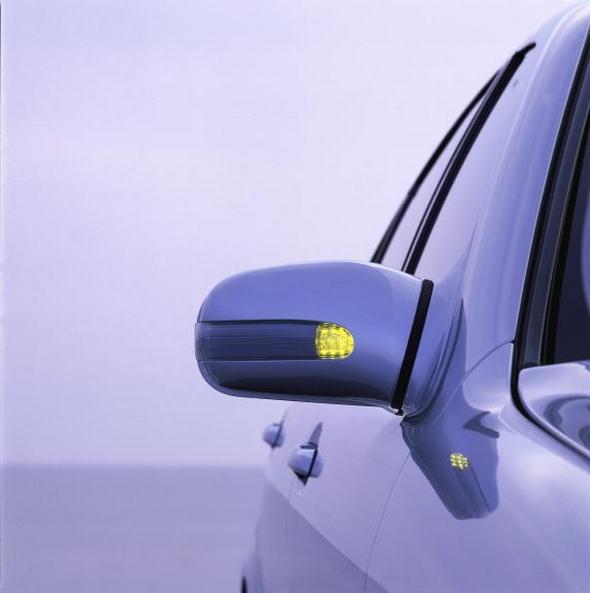
In an accident, the airbag inflates within only 25 milliseconds and stretches like a curtain between A-pillar and C-pillar. The window bag protects both the front and rear passengers and reduces the risk of head injuries.
A front passenger airbag with two-stage gas generator is also introduced for the first time.

This generator inflates the airbag according to the severity of the crash. If the sensors detect a minor front-end collision, only one chamber of the generator is ignited, and the airbag is less fully inflated.
As a result , the energy absorption by the airbag can be controlled as a function of actual need.

At the market launch of the 220 series S-Class, customers could choose from two length wheelbases and initially from three engine variants: the S 320 with the 3.2-liter V6-engine taken from the M 112 series and the S 430 or S 500 with the 4.3-liter and 5.0-liter V8-units from the M 113 series.

All three engines belong to the new generation of V-engines featuring the 3-valve technology and dual ignition already familiar from the E- and C-Class and refined SL models.
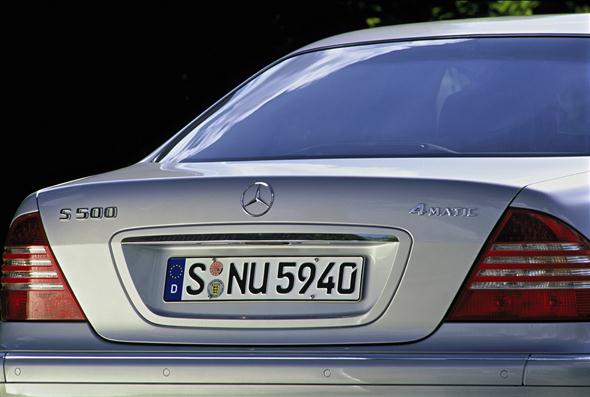
A newly developed automatic cylinder cut-out system, which is available for the first time as an option in the S 500, converts the 8-cylinder engine to a 4-cylinder unit, without any loss of smoothness, torque or silent-running.

By cutting out four of the eight cylinders in the part-load range, the fuel consumption of the S 500 is reduced by up to 7 % in the NEDC (New European Driving Cycle), by about 13 % when cruising at a constant speed of 120 kph and by as much as 15 % at a constant 90 kph.

The automatic cylinder cut-out is activated when the V8-engine only has to supply part of its power and torque, for example in urban traffic, on country roads or when cruising on the motorway in the medium speed range.

As soon as the engine is only operating in the part-load range, the electronic engine control unit deactivates combustion chambers 2 and 3 on the right-hand cylinder bank and cylinders 5 and 8 on the left-hand bank.

The engine computer prevents any sudden torque change by briefly changing the throttle valve position and ignition timing.

If an increase in performance is required, the four silenced cylinders are reactivated, in a split-second, and without the slightest jolt, and the engine provides majestic acceleration.
Even without the cylinder cut-out system, the environmental sensitivity of the S-Class is a prominent feature.

Modern lightweight design, exemplary aerodynamics and the latest in advanced engine technology combine to create a fuel saving in the NEDC driving cycle of 13 % to 17 % on the outgoing model.

The new V-engines stand out thanks to their additional secondary air injection and sophisticated catalytic converter technology as well as through the particularly low level of pollutant emissions that they produce.

All models of the 220 series are standard-fitted with an electronic 5-speed transmission which is distinguished by two different drive modes and a slip-controlled torque converter lockup clutch.
In the S-Class, this modern lightweight transmission is combined with a newly developed “one-touch” gearshift system.

In the “D” position gears 4 to 1 can be selected by gently nudging the selector lever to the left or right.
The electronic control unit of the transmission monitors these manual gear selections and only executes them if they are compatible with the permitted engine speed range.

A display in the instrument cluster informs the driver of the current shift range. With the innovative driver-assistance systems, the S-Class attains new dimensions in comfort.

The highlight of the new developments celebrating their world premiere in large-scale car production is the optional DISTRONIC autonomous intelligent cruise control, which keeps the new S-Class at the selected safe distance from the vehicle in front.

The centerpiece of the system, which comes into its own on crowded motorways, is a radar sensor in the radiator grill. Other new features include the actively ventilated comfort seats with ten electric fans in the seat cushions and backrest upholstery.

They draw in air from immediately underneath the seat, where subjectively comfortable temperatures prevail even in a very hot car.
The air is then evenly distributed over the entire seat surface by plastic channels and a special ventilation fabric, thereby removing any dampness from the perspiration of the occupants.

Even greater comfort can be attained by another innovation of the new S-Class, namely the dynamic multi-contour backrest, available as an option, which comes with seven individually adjustable air cushions and further relieves the stress on the driver, in particular on long-distance journeys.

Pulsating air chambers in the backrest force the spinal column repeatedly to modify its position slightly but effectively, helping to create the “dynamic sitting” conditions recommended by orthopaedic experts.
The automatic climate control system fitted as standard in the new S-Class includes several newly developed features.

Information from different sensors allows individual seat climate control. The system determines the optimal air volume based on the number of passengers in the car.
An innovative multi-function sensor measures relative humidity and temperature and automatically closes the air recirculation flap in the event of a sudden increase in pollutants in the atmosphere.

Exposure to sunlight is recorded by a sensor on the air intake grid in front of the windscreen. This sensor covers a range of 360° and therefore delivers accurate information on the angle of incidence of the sun.
In this way, the system detects the seat that is most intensively exposed to sunlight and can therefore control this area specifically.

The S-Class is the first car in the world to have an individually variable air conditioning system that is sensitive to the position of the sun.

The functions of the door key and ignition key can be performed in the new S-Class by a handy chip card (option) that you never even need to take out of your handbag, shirt or jacket pocket to use.

To enter the car, the driver simply has to touch a door handle: in response, the “Keyless Go” system carries out a split-second data exchange with the vehicle by induction and radio signal in order to identify the driver.
The door is then unlocked. To start the engine, the driver simply presses a button on the selector lever.

Another contribution to the outstanding ride comfort of the new S-Class is the newly developed standard-fitted AIRmatic (Adaptive Intelligent Ride Control) which combines pneumatic suspension with an adaptive damping system.
AIRmatic adapts the hardness of the shock absorbers automatically to the condition of the road surface, the car’s payload and the driver’s style of driving.

The air suspension comprises a number of different components that are interconnected by pneumatic pipes and a CAN databus (Controller Area Network) and which includes pneumatic suspension struts at the front and rear, compressor, central reservoir, air spring valves, electronic control unit and various sensors.

The suspension is an open system in which the vehicle weight is supported by the compressed air enclosed in the newly developed rubber bellows of the pneumatic suspension struts.
Level control is obtained by supplying or releasing compressed air as and when required with split-second response.

This process is actuated individually at each wheel by means of fast-acting solenoid valves. The pneumatic suspension of the new S-Class not only automatically balances out different load conditions but also enables the vehicle level to be raised manually.
This function is particularly useful when driving over dirt tracks, for example, or stretches of road in bad repair (pot-holes).

At speeds of over 140 kph the body of the car is automatically lowered by 15 millimeters. For the front axle of the new S-Class, Daimler-Benz has developed a four-link system of aluminum and steel to replace the previous twin control arm suspension.

The separation of the previous lower control arm into spring link and torque strut has a positive effect on the overall kinematics of the axle and reduces vibrations which may be caused by tire imbalance or when braking.

The multi-link independent rear suspension developed by Daimler-Benz for the rear axle has been adapted to the technology of the new S-Class by recalculating the position of the damper struts.
The weight of the rear axle carrier has been reduced by 45 % thanks to its light alloy construction.

The 220 series S-Class sedan is fitted as standard with the “Electronic Stability Program” ESP, the world’s most sophisticated dynamic handling control system.
This system also contains the acceleration skid control ASR, the anti-lock braking system ABS and the “Brake Assist” BAS. The design of the brake system is based on experiences from motor sport.

Four-piston fixed-caliper disk brakes with a cast steel and cast aluminum composite construction are fitted for the first time.
The dimensions of the internally ventilated high performance brake disks featured in the V8-model are otherwise normally only found in high-caliber sports cars.

In the interests of optimal brake cooling, the cover plates of the front disk brakes have been reduced in size.
At the same time, Daimler engineers have developed perforated brake disks, the holes reliably diverting wet and dirt, providing excellent braking performance even under adverse weather conditions.

The innovative braking system not only brings the new S-Class quickly to a halt, it also makes an important contribution to the prevention of rear-end collisions.
LEDs are used in the new brake lights which light up about 150 milliseconds faster than conventional bulbs.

This means that the traffic following behind can react more quickly to the braking, allowing it to shorten its own stopping distance by crucial meters.
The lighting unit was integrated into the digital databus network of the S-Class and, with new and improved lighting functions, provides even better safety and comfort than its predecessor.

The driver can program the lighting system of the S-Class to switch on the low-beam headlamps, side lights, rear lights and number plate light automatically whenever the engine is switched on.
Alternatively, automatic headlamp control is also possible.

A sensor allows the system to detect when it is getting dark or when the vehicle is entering a tunnel or garage and automatically switches on the exterior lights. “Cockpit Management and Data System” (COMAND) is the name of another innovation featured in the 220 series S-Class.

This optional system gives drivers a variety of new and extra functions that can be controlled from a central control panel.
The visible center-piece of this multi-function system is a 12 cm diameter color display unit that displays the control functions and information messages.

The invisible brain behind the display is a 32-bit processor that controls all functions, manages the programs and is also capable of transmitting video or TV pictures to the display.

In addition to the “Dynamic Auto Pilot System” DynAPS, which, for the first time, takes current information on traffic jams into account in calculating the best route, the central control block contains a cassette player and high-quality car radio with two FM tuners.

Depending on the customer’s specific requirements, a CD changer, sound system, car phone and LINGUATRONIC voice control system can also be connected to COMAND.
The driver or front passenger can select the various systems simply by pressing the appropriate button above the color display.

The selected system is then operated mainly by the combined turn-and-press knob: the desired menu items on the display are first marked by turning the knob, and then the marked functions are activated by pressing the knob.
The driver can also control individual COMAND functions by means of buttons on the multi-function steering wheel of the new S-Class.

W220 S-Class Guard bulletproof windows
The required information is then displayed on both the color display in the center console and the central display in the instrument cluster, so that it is always in the driver’s field of view.
Production of the new S-Class takes place at the Sindelfingen plant, where Daimler-Benz invested some DM 290 million in setting up a new bodywork plant.

A staff of 500 will assembly exclusively 220 series S-Class bodies-in-white on 23.000 square meters.
With “solitary manufacture” the company achieves numerous advantages as far as improvements in productivity are concerned, such as simplified logistics, a clearly laid-out design and everything being within easy reach.

TEST: W220 S500 2000 for a year
Buyers guide to the W220 and C215 CL S-Class Sedan and Coupé
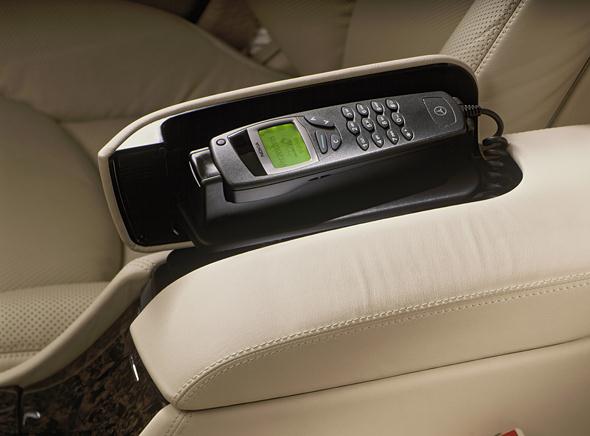












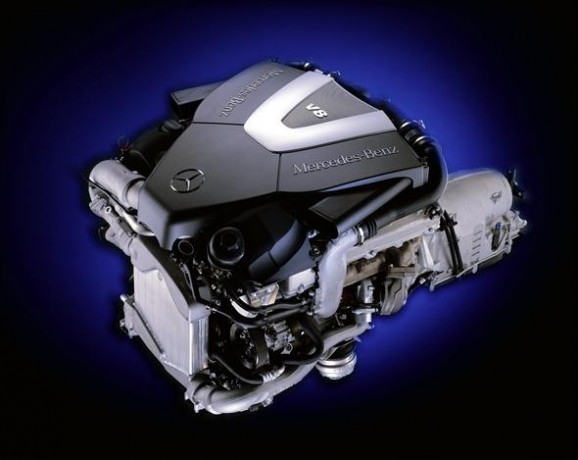





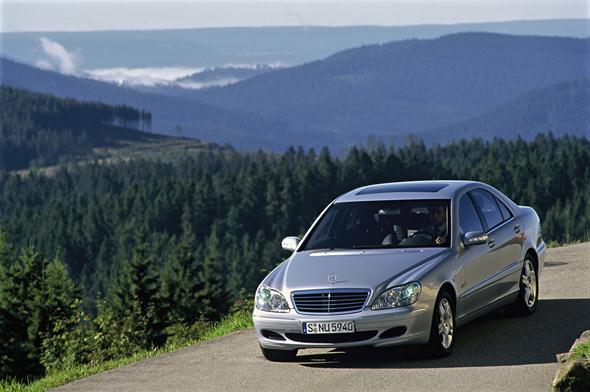



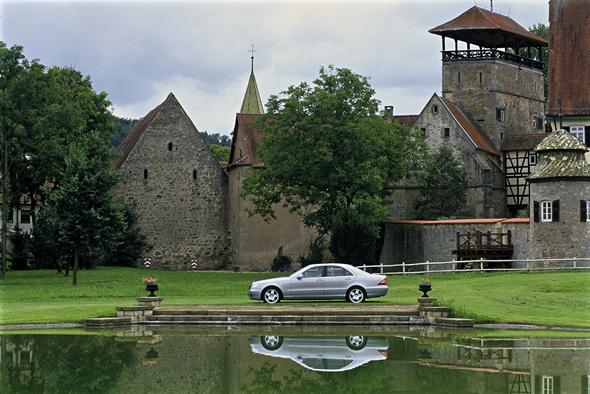








DaimlerChrysler: The latest generation of hybrid technology in the Mercedes-Benz S-Class
- Progressive P1/2 hybrid drive system combined with Mercedes-Benz V8 CDI diesel engine celebrates its premiere at the 2005 NAIAS
- Basis for advanced development of hybrid technology in association with General Motors
- DaimlerChrysler board member Dr. Thomas Weber: “Our solution ensures high driving dynamics and enhanced comfort at the same time as significantly reduced fuel consumption.”
Detroit/Stuttgart – With its progressive P1/2 transmission, DaimlerChrysler is the world’s first manufacturer to develop hybrid technology that combines a powerful drivetrain with a highly efficient design concept, while at the same time meeting the highest demands in terms of driving dynamics and comfort.
At this year’s North American International Autoshow (NAIAS) in Detroit, the company is presenting the latest generation of hybrid drive in the Mercedes-Benz S-Class “Hybrid” in combination with a highly efficient V8 CDI diesel engine.
With the P1/2 concept, DaimlerChrysler’s engineers have perfected the combination of internal combustion engine and electric motor to such an extent that the transition between operating modes now takes place almost unnoticed.
The hybrid concepts presented on the market until now have been suitable above all for small or medium-sized internal combustion engines.
“Our technology is ideally matched to powerful engines. We thus ensure a high level of driving dynamics and enhanced comfort at the same time as significantly reduced fuel consumption,” said Dr. Thomas Weber, member of the Board of Management of DaimlerChrysler AG with responsibility for research and technology and the development of the Mercedes Car Group.
This concept, now presented to the public for the first time, forms the basis for the advanced development of hybrid technology in association with General Motors.
The two companies have announced a program which will serve to drive forward the use of state-of-the-art hybrid technology. Mercedes-Benz is to focus on the development of premium class rear-wheel drive cars with a hybrid unit.
The drivetrain in the new Mercedes-Benz S-Class “Hybrid” develops a maximum power of 241 kW/340 hp – a new record for cars with hybrid drive systems.
The V8 CDI diesel engine develops 191 kW/260 hp and 560 Nm of torque. The two electric motors, which have a combined output of 50 kW/70 hp, make for optimized ride comfort and acceleration.
Thanks to the second electric motor, the diesel can be started at any time without transition, independently of driving mode. The electric motors are powered by a 1.9 kWh nickel-metal hydride battery in the trunk of the S-Class vehicle.
Energy is recovered during braking, and the V8 diesel engine recharges the battery while the vehicle is in motion.
The S-Class Hybrid accelerates from 0 to 100 km/h (62.1 mph) in 7.6 seconds.
The design of the drivetrain is surprisingly simple but highly efficient: Unlike many conventional hybrids, the system dispenses with a torque converter; this is replaced by the hybrid-specific components.
The hybrid concept is based on the 7G-Tronic automatic transmission in combination with the P1/2 hybrid transmission, which thanks to its compact dimensions does not restrict interior space.
“The use of the 7G-Tronic automatic transmission makes for a comfort level that is unique in the world of hybrids,” emphasized Weber. “Shifting is even faster and more convenient in continuously variable mode.”
The quiet pace of progress
The efficient combination of electric drive with the 7G-Tronic automatic transmission ensures that the S-Class “Hybrid” constantly operates at the optimum level.
Not only during accelerating from standstill, parking, in bumper-to-bumper traffic and when traveling slowly through restricted traffic areas, but also when driving at a constant speed, the hybrid concept ensures that the diesel can constantly operate in the most fuel-efficient range.
“This reduces fuel consumption by 15 to 25 percent depending on the driving cycle, while at the same time enhancing comfort,” says Prof. Herbert Kohler, Head of the Vehicle Body and Drive Systems Directorate at DaimlerChrysler AG. “Fuel consumption amounts to 34 miles per gallon, or about seven liters per 100 kilometers.”

















































































































































































































































































































































































































































































